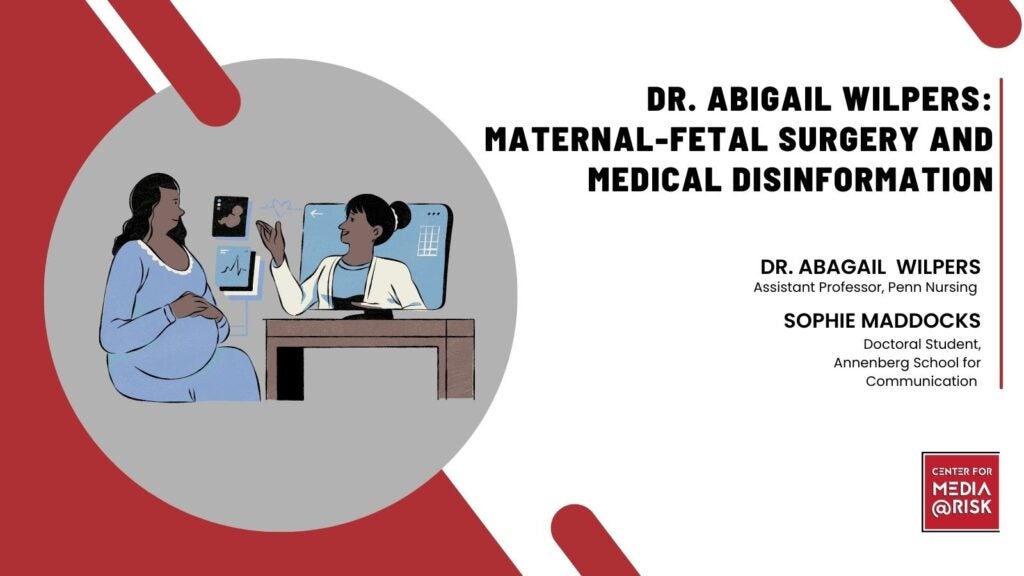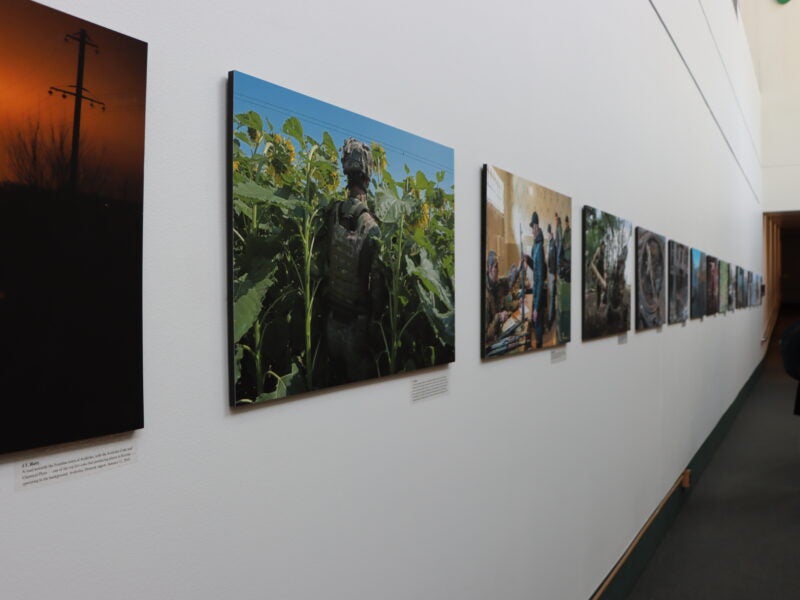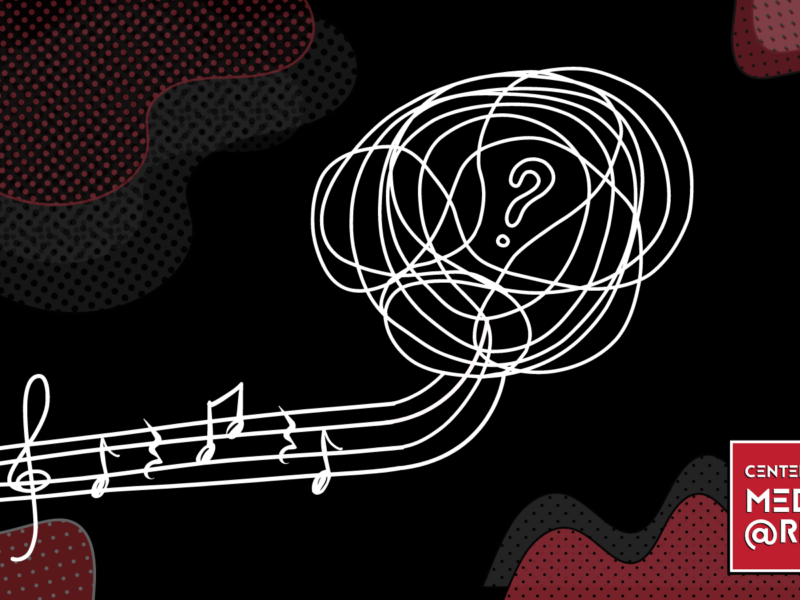
For this installment of our Reflections series, Media at Risk’s Sophie Maddocks interviews Abigail Wilpers, nurse, scientist and Assistant Professor at the University of Pennsylvania’s School of Nursing. Specializing in maternal-fetal health, Dr. Wilpers works across pro-choice and anti-abortion divides to advance health equity for women and pregnant people. In a recent op-ed, she spoke out about the dangers of disinformation campaigns that position maternal-fetal surgery as a replacement for abortion. In this interview, we talk about the spread of abortion-related disinformation, the use of maternal-fetal surgery images as visual propaganda and the challenges of building solidarity in a post-Roe world.
Sophie Maddocks, Doctoral Candidate and Research Fellow, Center for Media at Risk
Q. Prompted by the overturning of Roe Vs. Wade in 2022, you co-authored an op-ed titled “Maternal-fetal surgery is not an alternative to abortion care.” In this article you demonstrate how disinformation about maternal-fetal medicine impacts the abortion debate. Before we dive into that, what is maternal-fetal surgery and how does it intersect with abortion care?
Pretty much no one expects to hear that their pregnancy is complicated by a severe fetal condition. Most people come to their appointments very excited to see their baby at their 20-week scan. (You’ll notice my language changes depending on context. I’ll use the term fetus when speaking medically, and when I’m speaking about the perspectives of people who view their fetus as a baby, I use their preferred terminology). When they find out about a fetal condition their world falls apart. Many conditions aren’t detected until the second trimester ultrasound (between 18-22 weeks), and so in a post-Roe world more and more families are losing the option for an abortion due to bans or extremely early gestational age cut offs. Even with common pre-Dobbs cut offs at around 23 weeks, families still have little time to understand what’s going on, receive all the diagnostic results, process that information, be told about their options, make a decision and then find care.
Maternal-fetal surgery refers to any in-utero surgical procedure to treat a fetal condition. Depending on the condition and the treatment, these procedures can sometimes save lives, but more often they mitigate the negative health outcomes of fetal conditions. The more invasive the procedure, the greater the risks are to the pregnant person, which can include maternal illness or even death.
One of the scarier pre-Dobbs stories that I’ve heard is about somebody who had chosen to terminate their pregnancy due to a fetal condition, but they couldn’t afford it because it wasn’t covered by Medicaid in their state and they couldn’t afford to travel out of state. Their medical team wanted to help, but since they couldn’t influence the cost of an abortion that would have taken place outside their practice, the only cost they could influence was the cost of a maternal-fetal surgery procedure (that the patient didn’t originally want). So, they advocated to have the hospital cover those costs so that at least this person had an affordable option (at least in the short term) that also mitigated some of the negative health outcomes of the fetal condition. But this person had decided that they didn’t want to continue the pregnancy and now they’re not only going to be continuing it, but undergoing surgery, dealing with their own recovery and supporting a medically fragile child without these future costs being covered. In this case, I think it’s very doubtful that the hospital would have covered the cost of a postnatal intervention rather than prenatal (which would have been the patient’s other option). So, you can see how even with the best of intentions from clinicians, when abortion is not equitably accessible, people can much more easily end up in a situation where it’s very difficult to say ‘no’ to maternal-fetal surgery.
Q. Maternal-fetal surgery is a growing field that can provide essential care for those whose pregnancies are complicated by fetal conditions. But it can never replace the option for abortion. How have anti-abortion leaders, legislators, journalists and faith-based organizations spread mis- or disinformation about maternal-fetal surgery?
Very few people know what maternal-fetal surgery is. Yet, some anti-abortion activists and legislators who have found out about it and either misunderstand it or purposefully twist the facts to justify their agendas. The first time I noticed this was when the House Energy and Commerce Committee held an emergency hearing in response to the Dobbs Decision. Representative Gary Palmer tried to use a famous image called “hand of hope,” which was taken in 1999 during an open maternal-fetal surgery, to further his anti-abortion agenda The image shows a fetal hand that looks like it is reaching out of the womb during the procedure and grasping the finger of the surgeon. But this is not what happened. The surgeon explained that the fetus was anesthetized and it could not move. What actually happened was that the hand was pushed out of the womb and the surgeon was using his finger to put it back in. But that correction did not make the headlines in the same way the original incorrect story did. After being circulated for twenty years among anti-abortion activists and faith-based organizations, Representative Palmer brought the image to the hearing in 2022 and tried to enter it and the false narrative into the congressional record. Although it was disallowed because he hadn’t followed the committee’s rules for admitting documents, thousands of people saw and responded to the image and story via a Forbes video recording of the hearing.
Similarly, Lindsey Graham’s National Abortion Bill falsely claimed that because anesthesia is used in some maternal-fetal surgery, it proves that the fetus has the capacity to experience pain during an abortion and therefore termination of pregnancy should be banned after 15 weeks. In fact, there’s well-documented evidence that the brain structures necessary to process pain signals do not develop until at or after 24 weeks of gestation. And anesthesia is not used in maternal-fetal to address fetal pain, rather to stop the fetus from moving. So, he’s using mis- or more likely disinformation about maternal-fetal surgery to support a gestational age cut off at 15 weeks that makes no sense.
In a similar case, during a hearing on the Women’s Health Protection Act of 2022, Congresswoman Cathy McMorris Rodgers closed her argument to reject abortion by saying that because “doctors can perform prenatal surgery on 20 different organs.” She said: “abortion is not following the science. It doesn’t reflect the latest research or modern medicine”. In other words, she’s saying that abortion due to a severe fetal condition is no longer necessary because maternal-fetal surgery treats these conditions. And that is just not true. There are not 20 different fetal organs that can be operated on and the success rates for maternal-fetal surgery vary significantly. In addition, there are major risks to the pregnant person, not everyone is eligible and most procedures are not life-saving. In fact, some maternal-fetal surgery actually involves abortion care because in some cases of complex twins, if one twin is expected to die, then pregnancy reduction (the abortion of one twin) is necessary to save the life of the other.
Q. Some of these examples appear to operate by falsely positioning abortion as a brutal and backward process and positioning maternal-fetal surgery as the “good” choice. How do the media usually talk about pregnant people who seek to terminate a pregnancy? And in contrast, how do the media frame women who choose perinatal palliative care, or choose maternal-fetal surgery?
Recently the Vatican held a public webinar about perinatal palliative care. That’s the care that people receive if they choose to continue a pregnancy with a life-limiting fetal diagnosis. In other words, the pregnant person is expected to experience fetal demise, stillbirth, or the baby will not survive for very long after birth, no matter what intervention is attempted. So, you can imagine why the Vatican favors this option because it’s a continuation of life, where people might be likely to terminate a pregnancy. I think perinatal palliative care is beautiful, and it is one of my favorite things about the work in this field. It can be an incredibly therapeutic and important experience for people. However, it is not necessarily the right choice for everyone. In this webinar, Arch Archbishop Vincenzo Pagliapromoted perinatal palliative care as an alternative to what he called a “prevailing throwaway culture” where people terminate pregnancies and don’t stay with their babies until birth. To me, it is so sad that we can’t celebrate this beautiful, important type of care without demonizing people who choose abortion.
I think this story reflects the story in the wider media. That if you are pregnant with a fetal condition and you choose to continue the pregnancy, that is a heroic move – those are the “good” parents. Media representations of “heroic moms” who choose to undergo surgery can make us think that these are the only honorable choices. But that is just not what you see when you actually talk to people who go through these experiences. Many people choose termination because they are trying to mitigate the suffering that their baby might go through. And I think that is the opposite of a throwaway culture.
Q. There is so much heroism and self-sacrifice in all of these choices. And I can’t imagine someone sticking to these “heroic” versus “throwaway” tropes if they actually saw the decision-making processes pregnant people go through. But we so rarely hear from the people who make these decisions. We have predominantly male legislators, journalists, religious leaders and surgeons shaping the discursive construction of pregnant people’s choices. Have you seen news articles that sympathetically describe the experiences of someone navigating this decision-making process?
This makes me think of a woman in Florida whose fetus was diagnosed with Potter Syndrome, which is a life-limiting condition. She wished for an abortion, but her providers would not give that to her because they were worried about legal liability because it fell in a gray area of their recent anti-abortion legislation. She wasn’t comfortable traveling outside of Florida because she was worried that there would be legal repercussions for her when she came back. A Washington Post article provided an extremely poignant description of how continuing this pregnancy, effectively being forced into perinatal palliative care, is taking a huge toll on her mental health. To my knowledge, these kinds of stories rarely get media attention. But some very brave people choose to amplify their own heartbreaking stories by sharing them on social media or providing them at policy hearings. In a 2016 Capitol news conference opposing the passage of what would have been the nation’s most restrictive abortion law, my close friend and colleague, Dr. Erica Goldblatt Hyatt, shared their story of choosing abortion care for their very loved son, Darby, after he was diagnosed with a life-limiting condition.
Q. These examples remind me of an NPR article that offered a similar patient-centered framing. I wish we could see more of this in the media. You work across the anti-abortion and pro-choice spectrum, which puts you in a contested space within the women’s health sphere. I’m inspired by the way you maintain so much space for people’s differing values about their bodies and their reproductive choices. How do you manage to build solidarity across this contested space?
My approach is the same as the clinicians who are on the front lines of this, including people whose religious beliefs may sometimes conflict with these values and practice. These very brave clinicians are so important because they can help faith-based communities understand how their own views may change if they are confronted with these real-life tragedies and decisions. And I think that is because when you work – day in and day out – with people who are going through these experiences, that are often described as the worst days of their lives, it’s very difficult to make it black and white.
We want to make sure that we’re all feeling seen, heard and respected in the process of assessing the evolution of a new medical field that can really save lives and can be a miracle for some people, but for others can be part of a harm that they go through. I think it’s important that we all feel comfortable to speak honestly about that.
People holding space for many different perspectives is wonderfully common in my colleagues. What’s unfortunate, is how hard it can be to translate that to academic work and health systems changes. Once this compassion is filtered through the patriarchal and systemically racist culture of the healthcare industry and of academia, that starts to get chipped away at. For example, if clinician researchers want to use scholarship to amplify the voices of their patients and promote a better understanding of these stories, they might wish to conduct qualitative research, which focuses on the words of people with lived experiences, rather than quantitative research which represents data in numbers. But qualitative research is much harder to get funded and published, in part, because it doesn’t generalize the way quantitative research can. And these cultures and systems value numbers and generalizations over words and individual representation. So, people’s compassion – mine too – has to get filtered through this currency of grants and publications, because that’s how our success is measured in academic health institutions. That’s not to say we can’t and don’t push through and publish important qualitative work, it’s just much harder to get support for that.
Q: As a nurse scientist and health services researcher, how did you personally experience the fallout from the overturning of Roe Vs Wade?
My world, my community and my career have all been turned upside down. There were women’s health communities that knew this was likely to happen, and the conversation was ramping up as the decision got closer. But the rest of the world seemed less aware that this was possible. Last spring, I remember speaking with an editor from a major national news outlet about health policy, and she explained the resources they dedicated to different health policy issues. Out of all the health topics on their radar, they had the smallest number of reporters focused on abortion policy – maybe just a single journalist. I remember saying, “Why not more?” And she said she couldn’t imagine that Roe v Wade would really be overturned, and even if it was, people would still have access to medication abortion. And I realized, okay, people aren’t necessarily seeing the massive shift that’s coming.
And even for the folks that saw it coming, this is what every meeting is about now. And it’s tough timing to have it come during COVID, because people were already burned out in many ways. Now we are working in a field that’s under greater attack than it has been in most of our professional careers. People are tired, but still fighting every day. So, if any of your friends or family are women’s health providers, give them a hug!
Q. What does the future hold for your work in this area? What projects are you working on?
I do quantitative research as well, but in my heart I’m a qualitative researcher. I’ll choose words over numbers any day. And I love that there is growing qualitative work being done in this field by nurses and social workers, and I think that’s very exciting because those are often the people who are talking with patients about what these care options mean in the broader context of their lives. There are also disparities in who seems to be undergoing maternal-fetal surgery, and we need a better understanding of the upstream factors that are causing a lack of diversity and representation in this space.
Dr. Abby Wilpers is an Assistant Professor at Penn’s School of Nursing. Through policy-relevant and community-engaged research, she strives to build knowledge and partnerships between maternal-fetal medicine and the Reproductive Justice movement to enhance care and equity for people experiencing fetal complications during pregnancy. Follow her on Twitter @AWilpers
Sophie Maddocks is a doctoral candidate at the Annenberg School for Communication and a Member of the Center for Media at Risk’s steering committee. Her work charts the everyday experiences of adolescent girls in relation to sexuality, technology and identity. Follow her on Twitter @Sophie_J_J


